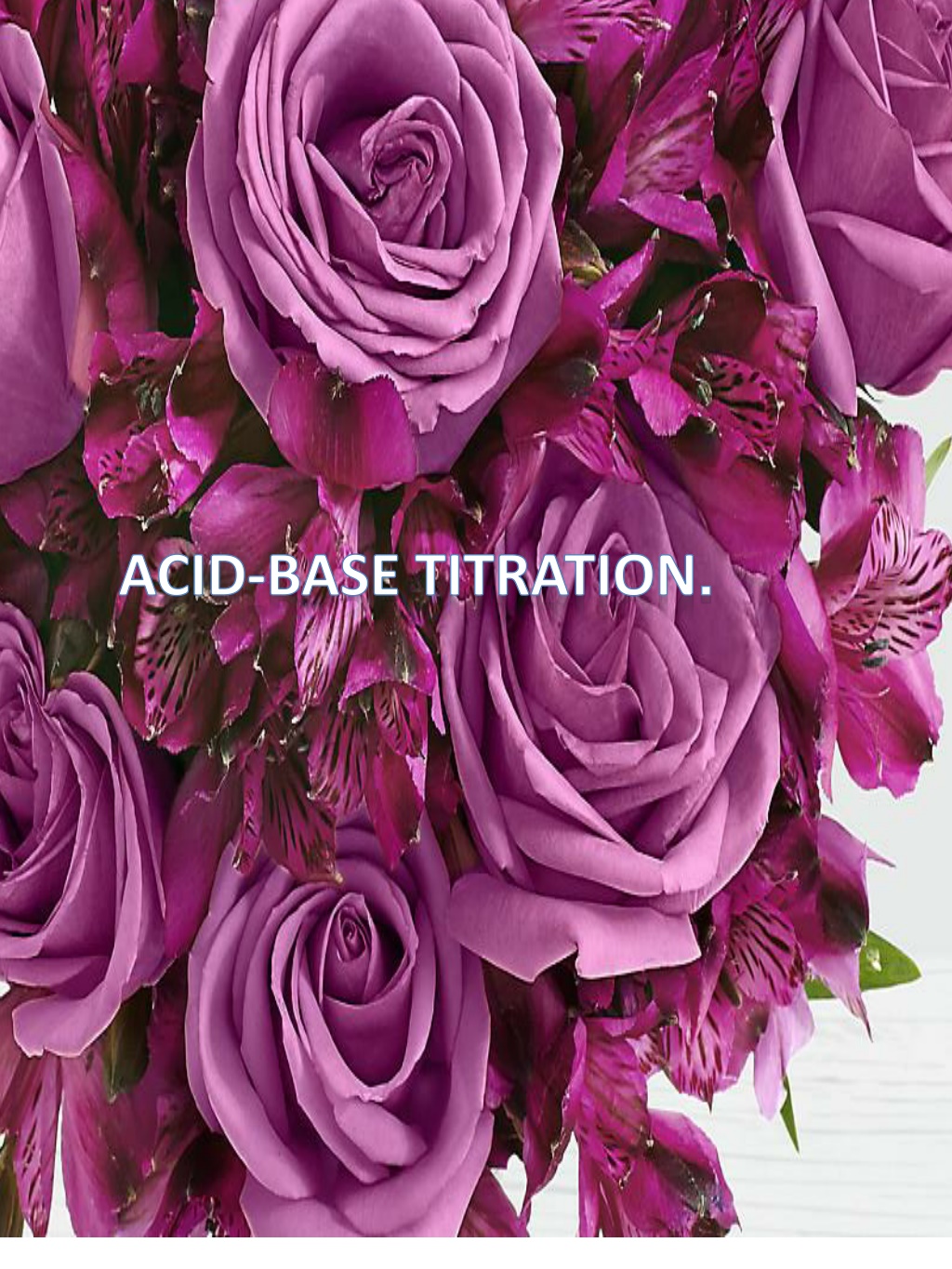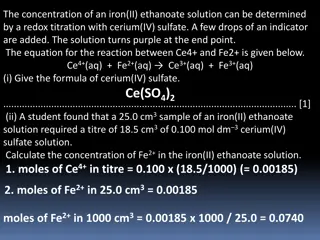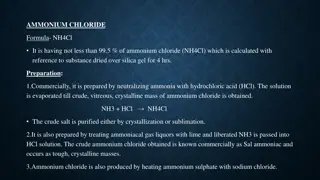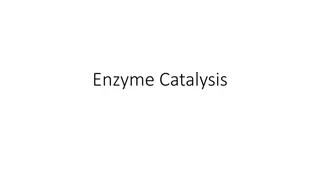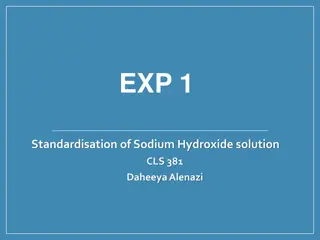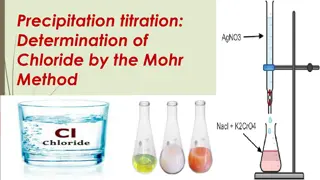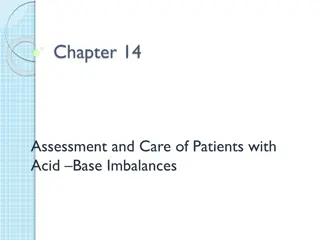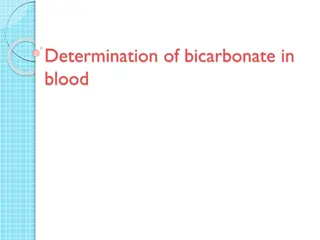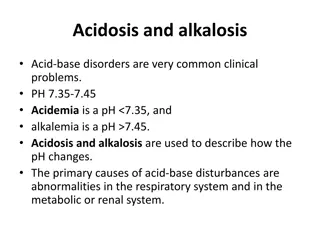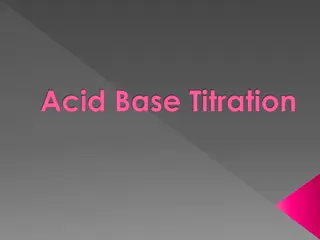Understanding Acid-Base Titration in Analytical Chemistry
Analytical chemistry involves analyzing material samples to determine their chemical composition. Acid-base titration is a technique used to find the concentration of an unknown solution by reacting it with a known concentration solution. This process, involving neutralization reactions and pH indicators, is crucial for various applications such as environmental monitoring, material development, and drug manufacturing. The step-by-step process and calculations involved in a typical titration experiment are outlined thoroughly in the provided content.
Download Presentation

Please find below an Image/Link to download the presentation.
The content on the website is provided AS IS for your information and personal use only. It may not be sold, licensed, or shared on other websites without obtaining consent from the author. Download presentation by click this link. If you encounter any issues during the download, it is possible that the publisher has removed the file from their server.
E N D
Presentation Transcript
ACID-BASE TITRATION. ACID-BASE TITRATION.
ACID-BASE TITRATION Analytical chemistry: is the analysis of material samples to understanding of their chemical composition and structure. It has a wide range of monitoring pollution in the environment, development of new materials, and drug manufacture. Titration technique: Titration is a technique used to determine the concentration of an unknown solution by using known concentration solution. Typically, the titrant (the known solution) is added in a burette to balance a known quantity (volume) of the analyte (the unknown solution). By knowing the volume of titrant added you can determine the unknown concentration solution. Neutralization: is a complete reaction of acid and base to form salt, and water the solution is called a neutral solution. Acid-base reactions are important for living things. Thus, it is important to know the concentration, of acids and bases in certain situations. During a titration, use a known volume of an acidic sample, and add base to it until the solution is neutral. Often, a pH indicator is used, to signal the end, of the reaction, the endpoint is the equilibrium point, where the amount of acid is equal to the amount of base present. pH indicators: Indicators are used in a titration, to show the completion of an acid-base reaction. The pH indicator is an chemical detector, for hydronium ions (H3O+) or hydrogen ions (H+) giving two or colors at the same solution depending on pH (Figure 1). Phenolphthalein is a colorless, weak acid which dissociates in water forming pink color, slight pink and colorless solution depending on a pH. The pink color is due to the presence of hydronium ions H3O+. Under acidic conditions, the concentration of the hydrogen ions (H+) cause the colorless solution to be observed (Figure 2). NaOH + HCl NaOH + HCl H H O + NaCl O + NaCl
A pH indicator changes color in response to changes in acidity or alkalinity. Cultura Exclusive/GIPhotoStock / Getty Images Figure 1: A pH indicators after titrations. Figure 2: A pH indicator Phenolphthalein changes color in response to changes in acidic or basic solutions. Materials: Use distilled water to wash all glass wears. Equipments (glass wears): Burette Clamp - Erlenmeyer Flask- Funnel - volumetric pipette - 250mL beakers - washing bottle. Safety Tips: Safety mask & Gloves. Always wear masks and gloves. Steps: 1. Hold the burette on the clamp, leaving room for the flask underneath. 2. Measure 25mL of 0.1N base (known concentration) in the 250mL beaker. 3. Pour quantity of 0.1N base into the burette using the funnel. Record this volume in your notebook as initial volume. Notice the flow through, to clear any air bubbles near the burette tap. 4. Measure out 5mL of Acid (unknown concentration) by volumetric pipette and pour it in the Erlenmeyer Flask. 5. Put 2-3 drops of phenolphthalein on Acid in the flask. 6. Put the flask underneath the burette. You're ready to start the experiment. 7. Carefully add drops of base at a time to the flask. Figure 3: Acid- base titration.
8. Phenolphthalein is clear when the pH is acidic and turns pink if the pH is basic. Continue to add drop by drop of Base causing the acid turns a very light pink. This is the equilibrium point. 9- Record the reading of burette after titration(the acid turns a very light pink). 10- Rinse your equipment with distelled water, and repeat steps two times, to validate your data. Take an average of the readings. Calculations: 1. Calculate the volume of titrant (Sodium Hydroxide solution). Subtract the Initial volume from the Final volume to gain the Real Volume (the volume of titrant ). Final volume Initial volume = Real Volume 2. At end point the equivalent of acid = the equivalent of base. Na . Va Nb . Vb 3. Normality of Base given by lab. = N b The Real Volume of Base from burette readings = V b Acid Volume = 5ml = V a Unknown concentration of Acid = Na equation: N b . V b = Na . V a Molarity and Normality : The concentration of each solution is expressed by Molarity and Normality. 1-Molarity (M) is defined as the number of moles of solute/ liter of solution. (M) = moles of solute / liters of solution. 2-Normality is defined as the gram equivalent weight per liter of solution. Normality of Acid = (M)(number of hydrogen or hydroxide ions) Normality of Base = (M)(number of hydrogen or hydroxide ions) Normality(N) is equal to the molarity multiplied by the number of equivalents. Na . Va = equivalent of acid. Nb . Vb = equivalent of Base. N b V b V a Na is measured by the following N b . V b = Na . V a
